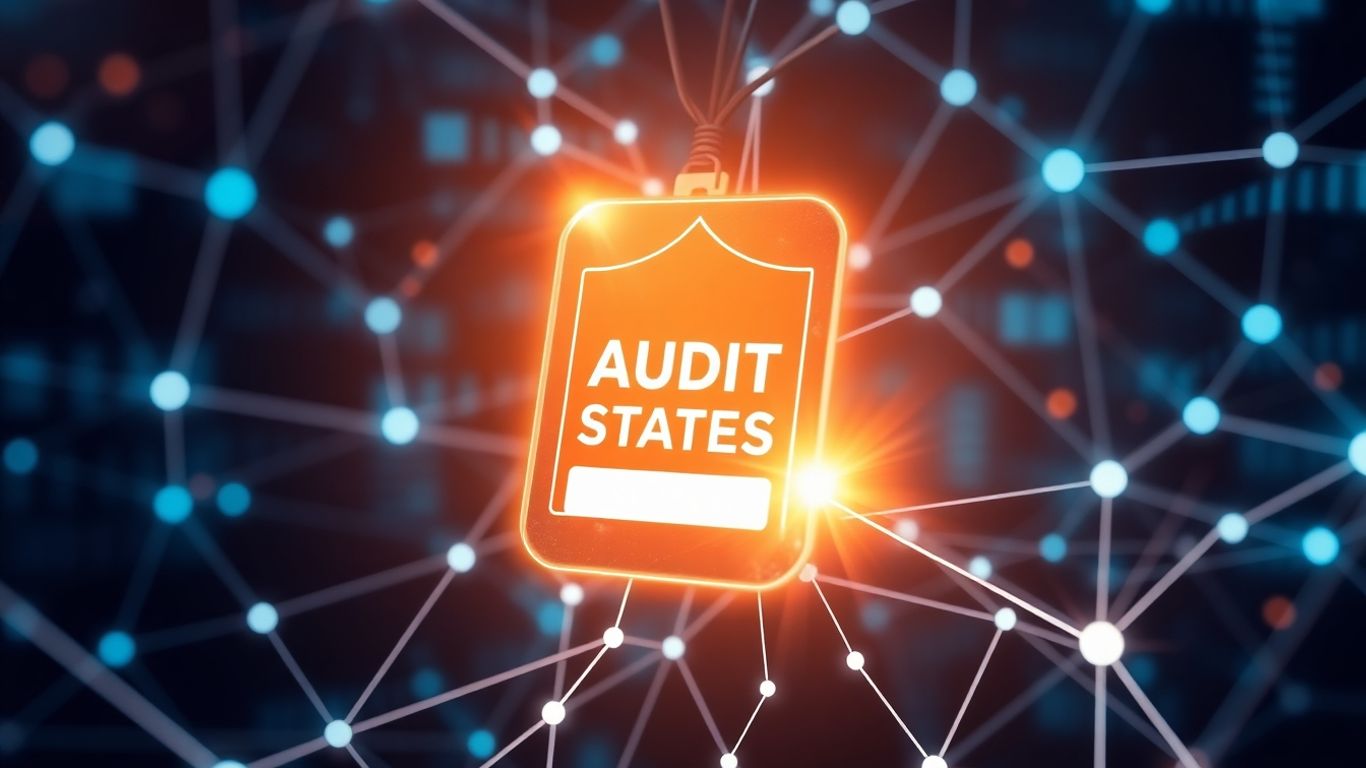[ newsletter ]
Stay ahead of Web3 threats—subscribe to our newsletter for the latest in blockchain security insights and updates.
Thank you! Your submission has been received!
Oops! Something went wrong. Please try again.
Showcase your project's security with an embeddable security badge. Get on-chain proof of audits and build trust through transparency.





Keeping blockchain projects secure is a big deal, right? We've all heard about projects losing money because of security flaws. It's a constant worry for developers and investors alike. Traditional security checks can be slow and expensive, leaving many projects vulnerable. That's where new ideas come in, like using AI to speed things up and make audits more affordable. And when it comes to showing off that a project has actually been checked, a security badge embed can make a real difference in building trust.
Think about it: when you're looking at a new project, especially in the fast-paced world of crypto, how do you know if it's actually safe? It's not always obvious. That's where visual cues come in. A security badge, like a little stamp of approval, can make a big difference. It's a quick way to see that a project has gone through some kind of security check. This visual confirmation helps build immediate trust with users and investors. It's like seeing a "certified organic" label on food; you know it's supposed to meet certain standards. For projects, it’s a way to show they’ve taken security seriously, which is super important when dealing with digital assets.
Transparency is key in the blockchain space. When projects are open about their security measures, it really helps build confidence. Imagine a project that just says, "We're secure!" without any proof. That doesn't inspire much faith, does it? But if they can show a badge that links to a detailed audit report, that's a whole different story. It means they're not hiding anything and are willing to stand by their security. This openness can lead to more people feeling comfortable investing or using their platform. It’s about creating a more honest and reliable ecosystem for everyone involved. We've seen how trust badges can really boost confidence on e-commerce sites, and it's the same idea here, just for digital assets.
In Web3, where things move so fast and the stakes can be high, security badges are becoming more than just a nice-to-have. They're becoming a standard way to signal legitimacy. These aren't just pretty icons; they can represent real, verifiable security checks. For instance, a badge might indicate that a smart contract has passed an automated audit, which is a big deal given how many exploits happen. Projects can display these badges on their websites or even directly on their profiles on different platforms. This makes it easier for users to quickly assess the security posture of a project before they commit their funds or time. It's a simple yet effective tool for improving the overall security awareness and trust within the Web3 community. Having these indicators readily available helps users perform quick due diligence in seconds.
Forget about waiting weeks for a security audit. We're talking about AI agents that act like a whole team of expert auditors, working together. These aren't just simple scripts; they're designed to dive deep into your smart contract code. They can spot potential issues, suggest fixes, and sometimes even implement those fixes right on the spot. It's like having a security expert on call 24/7, but way faster and more consistent. This multi-agent system can process huge amounts of code, looking for everything from common bugs to really tricky logic flaws that a human might miss after a long day.
Why wait for an attack to happen? AI can actually look at patterns in data, both on and off the blockchain, to predict where threats might pop up next. Think of it as a weather forecast, but for cyberattacks. By analyzing past exploits and current trends, these systems can give us a heads-up about potential vulnerabilities or scam attempts before they even become a problem. This means projects can get ahead of the curve, patching up weaknesses before bad actors can exploit them. It's a proactive approach that's way better than just reacting after the damage is done.
Security isn't a one-and-done thing. Especially in the fast-paced world of blockchain, new vulnerabilities can pop up all the time. AI is fantastic at continuously scanning code and network activity. It can detect issues as they emerge, not just during a scheduled audit. This means that even after a project has been audited and launched, the AI keeps watch. If a new exploit method is discovered or a subtle flaw is found in how contracts interact, the system can flag it immediately. This constant vigilance is key to staying secure in an ever-changing landscape.
Traditional security audits are like checking your car's brakes once a year. AI-powered continuous monitoring is like having sensors that alert you the moment your brake fluid is low or a pad is wearing thin. It's about staying ahead, not just catching up.
Here's a quick look at how AI speeds things up:
When it comes to securing your project in the fast-paced world of blockchain, you need solutions that are not just effective, but also efficient and affordable. That's where Veritas Protocol really shines. We've built a system designed to tackle the complexities of smart contract security head-on, moving past the limitations of older methods.
Forget about waiting weeks or months for a security audit, or shelling out tens of thousands of dollars. Veritas Protocol uses advanced AI to speed things up dramatically. Our system can complete audits in a matter of minutes, not days, and at a fraction of the cost. We're talking about saving projects up to 90% on audit expenses. This makes professional-grade security accessible even for early-stage startups that might not have huge budgets. It’s about democratizing security, making sure everyone has a chance to be protected.
Veritas isn't just about speed and cost. We provide a full suite of security tools. Our AI agents don't just scan for known vulnerabilities; they analyze contract interactions, check business logic, and assess dependencies across entire ecosystems. This means we catch issues that simpler tools might miss. We also offer:
The traditional approach to smart contract auditing often involves manual reviews that are slow and expensive, or automated tools that only catch a portion of issues. This leaves projects vulnerable to evolving threats and complex exploits. Veritas Protocol addresses this gap with an AI-driven system that provides both depth and speed.
Security isn't a one-time check; it's an ongoing process. That's why Veritas Protocol offers continuous monitoring. Our AI system works around the clock, analyzing your project for new threats and vulnerabilities as they emerge. This proactive approach means you're always protected, not just at the moment of an audit. We aim to provide a dynamic security posture that adapts to the ever-changing landscape of blockchain threats. You can check out the Veritas Explorer for more details on how we achieve this.

So, you've gone through the whole audit process, and your project is looking solid. Now what? You want people to know it's secure, right? That's where on-chain proof comes in. Think of it like a digital stamp of approval that lives on the blockchain itself. It's not just a pretty picture; it's verifiable proof that your smart contracts have been checked out. This is super important for building trust, especially in the Web3 space where things can get a bit murky. Having this on-chain record means anyone can look it up and see that your project has met certain security standards. It’s a way to show you’re serious about security without just saying it.
Okay, so you have this on-chain proof. How do you actually show it off? This is where embeddable badges become really useful. They're like little visual summaries of your security status. You can take that on-chain data and turn it into something easily digestible for your website or other platforms. It's about making complex security information accessible. These badges can show things like the audit status, the date it was completed, and maybe even a link back to the full report or the on-chain record. It’s a way to integrate trust right into your project’s presentation.
Here’s a quick look at what a badge might represent:
Where you put these badges really matters. You don't want them hidden away where no one can see them. A good spot is usually on your project's homepage, maybe in the footer or a dedicated security section. If you have a team page, putting them there can also show that your team members are associated with secure projects. For individual developers or contributors, adding them to your LinkedIn profile or a personal portfolio site makes sense. It’s all about making your security credentials visible and easy to find. Think about where potential users or investors will be looking for this kind of information and place your badges there. It’s a simple step that can make a big difference in how credible your project appears.
Displaying security badges isn't just about showing off; it's about providing clear, verifiable information that helps users make informed decisions. It builds confidence and reduces the perceived risk associated with interacting with a new project.

It's pretty wild how much AI is changing things, and security is no exception. For projects, think of it like having a super-smart, always-on security guard for your code. Instead of just checking things once in a while, AI can constantly watch for trouble. It's like having an AI debugger that doesn't just find bugs but also suggests how to fix them, right there and then. This means projects can get their code checked way faster and, honestly, a lot cheaper than before. It makes good security accessible even for smaller teams who might not have huge budgets.
This is where things get really interesting. AI agents can work together, like a team of digital detectives, to go through code. They're not just looking for obvious mistakes; they're trying to predict how someone might try to break things. When they find a problem, they don't just flag it. Some systems can even suggest or automatically apply fixes. This whole process is way quicker than a human team could manage, and it means projects can launch with more confidence. It's a big step up from just hoping for the best after a one-time audit.
For regular users, this means less guesswork. Imagine wanting to check out a new token or dApp. Instead of trying to figure out complex code yourself, you can use a tool that gives you a simple, easy-to-understand report. It's like a quick health check for any digital asset. You can get instant risk assessments for wallets or smart contracts, helping you avoid scams before you even get involved. This kind of scanning makes protecting your assets much more straightforward.
This is a game-changer for personal security. When you're looking at a wallet address, whether it's for a transaction or just checking out a project, AI can quickly tell you if there's anything suspicious about it. It can flag if a wallet has been linked to bad stuff in the past, like scams or illicit activities. This immediate insight helps users make safer decisions in real-time. It's like having a background check run instantly, giving you an extra layer of protection in the fast-paced crypto world.
The shift towards AI in security isn't just about speed; it's about a more proactive and accessible approach. By automating complex checks and providing clear, actionable insights, AI helps both developers and users navigate the digital landscape with greater confidence and safety. This technology is making robust security a standard, not a luxury.
Here's a quick look at what AI brings to the table:
This AI-driven approach is really about making the digital space safer for everyone involved, from the people building the projects to the individuals using them. It's a move towards a more transparent and secure future, where advanced security isn't out of reach for anyone. You can find out more about how these advanced security audits work by looking into AI security solutions.
The way we think about security in the blockchain space is changing, and fast. Gone are the days when a one-time audit was enough to call a project 'secure'. The landscape is just too dynamic, with new threats popping up all the time. We're seeing more complex attacks, and frankly, the old methods just aren't keeping up.
What we really need are systems that are always on, always watching. Think of it like having a security guard who never sleeps, constantly checking for anything out of the ordinary. This is where AI really shines. It can process vast amounts of data way faster than any human team could, spotting patterns that might indicate trouble before it even happens. This proactive approach is key to staying ahead of the curve.
Ultimately, this is all about making things safer for everyone involved. For users and investors, it means having better tools to check things out for themselves. Instead of just taking a project's word for it, they can look at clear, verifiable information. This builds confidence and helps people make smarter decisions with their money. It's about transparency and giving people the power to protect themselves.
This is where those embeddable security badges come back into play. They're not just pretty pictures; they're a quick, visual way to show that a project has passed rigorous checks. When you see a badge that links to verified audit data, it tells you something important. It means the project has put in the work to prove its security. This kind of on-chain proof is becoming a standard for legitimacy. It's a simple concept, but it makes a big difference in building trust in a space that can sometimes feel a bit wild west.
Here's a look at how these systems are evolving:
The future isn't about hoping for the best; it's about building systems that actively prevent the worst. This means moving from reactive fixes to proactive, intelligent security that's always adapting.
So, we've talked a lot about how showing audit status, like with a security badge, can really make a difference. It's not just about looking official; it's about building trust. When projects can easily show they've passed security checks, it helps users feel more confident. Plus, with tools like AI-powered audits becoming faster and cheaper, it's becoming more realistic for even smaller projects to get that stamp of approval. Ultimately, making security status visible helps everyone involved, from the developers to the people using the platform.
A security badge embed is like a small, digital sticker you can put on your website or profile. It shows proof that a project has been checked for security problems, kind of like a seal of approval. It helps people trust that the project is safe to use.
When a project gets its code checked (audited), it can display a badge. This badge acts as a quick visual clue that the audit happened and what the results were. It's a simple way to let everyone know the project has passed its security checks.
In the world of online projects, especially with money involved, trust is super important. Showing that you've had your security checked and displaying proof like a badge helps build that trust. It tells users and investors that the project owners care about keeping things safe and are being open about it.
Typically, you get a security badge after a project has gone through a formal security audit by a trusted company or service. It's not something you can just grab; it has to be earned by passing the security checks.
AI can help by doing a lot of the security checking much faster and sometimes more thoroughly than humans alone. It can find potential problems in code quickly. Once the audit is done, AI can also help generate and manage these security badges, making the whole process more efficient.
You can usually embed these badges on your project's website, in your social media profiles, or even on platforms where you list your project. The goal is to make them easy for people to see, so they know your project is secure.


